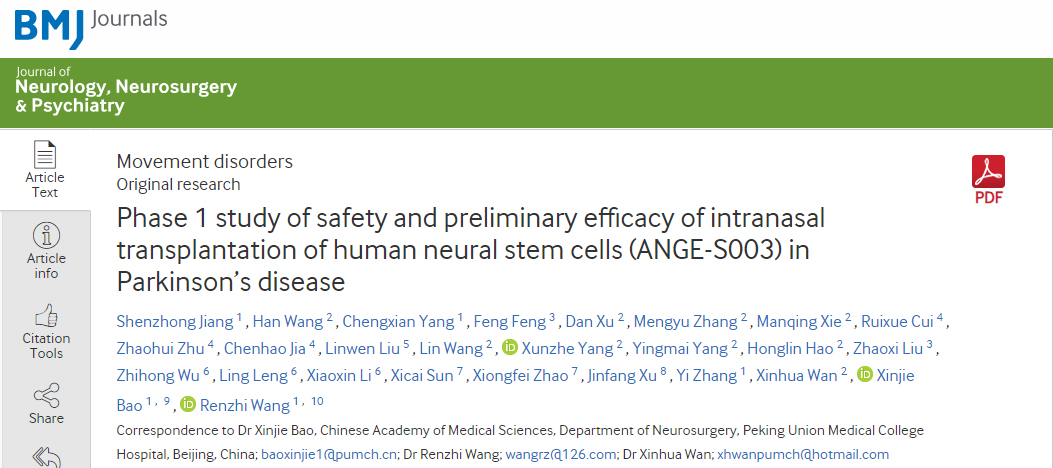Recently, a breakthrough was achieved in a “Phase 1 clinical study using human neural stem cells to treat Parkinson’s disease”, jointly conducted by Wang Renzhi and Bao Xinjie from the Department of Neurosurgery and Wan Xinhua’s team from the Department of Neurology at PUMCH. Unlike the standard method that transplants neural stem cells through the stereotactic brain injection, PUMCH team successfully adopted a non-invasive, intranasal approach to treat Parkinson’s disease (PD), which has proven safe and effective. The research results were published as an original article in the “Journal of Neurology, Neurosurgery & Psychiatry”, a top-tier journal, or among the top 5%, as ranked by the Chinese Academy of Sciences.

PD is a degenerative disorder of the central nervous system, primarily characterized by the progressive loss of dopaminergic neurons. Current treatments for PD involve medication and surgery, which temporarily alleviate symptoms but are unable to reverse the progression of disease. Recent studies suggest that neural stem cells in adults are capable of dedifferentiating into neurons. However, the disease itself reduces the proliferation ability of neural stem cells in PD patients. Several clinical trials worldwide are ongoing using exogenous neural stem cells to treat PD, mostly adopting invasive methods such as stereotactic brain injection or lumbar puncture for transplantation of stem cells.
The PUMCH research team discovered a “shortcut” for cell transplantation. The nasal cavity serves as a ‘back door’ to the bottom of the brain. The olfactory nerve, in its submucosa, on top of the nasal cavity acts as a natural ‘pathway’ leading directly to the brain, having great potentials to allow implanted neural stem cells to cross the blood-brain barrier and directly reach the target area.” To prove the feasibility of this “shortcut”, the team conducted a single-center, open-label, dose-escalation Phase 1 clinical study of intranasal transplantation of human neural stem cells for treating PD.
The study enrolled 18 patients with advanced PD for over 5 years. These patients were assigned to 1 of 3 groups to receive intranasal transplantation of human neural stem cells. The doses were: 1.5 million, 5 million, or 15 million. Patients underwent cell transplantation once a week for a total of four weeks. A 12-month follow-up assessment was conducted after treatment.
For safety evaluation, no clinically significant safety concerns or serious adverse events related to the treatment were recorded, and imaging examinations revealed no tumors or other abnormalities. For efficacy evaluation, researchers used the MDS-UPDRS (Movement Disorder Society-Unified Parkinson’s Disease Rating Scale) to assess mentation, behavior, mood, daily activities, motor function, and complications. Significant improvement of MDS-UPDRS global score was observed at all time points, starting from the 3rd month till the 12th month after treatment, particularly for motor function-related symptoms and quality of life. The most substantial improvement was seen at month 6 with a mean reduction of 19.9 points. The safety and efficacy of intranasal transplantation of neural stem cells were thus validated. There was no association between improvement in clinical outcome measures and cell doses.
“Compared with traditional transplantation methods of stereotactic brain injection or lumbar puncture, intranasal approach is more convenient and non-invasive and can be injected repeatedly. This method will effectively improve cell survival rate and functional integration efficiency, thereby achieving effective repair of neural networks and functional recovery.” The research team stated that a larger, longer-term, randomized, controlled phase 2 trial are warranted for further investigation.
Written by Jiang Shenzhong and Gan Dingzhu
Edited by Gan Dingzhu and Chen Xiao
Translated by Liu Haiyan
Reviewed by Guo Xiaopeng and Wang Yao
